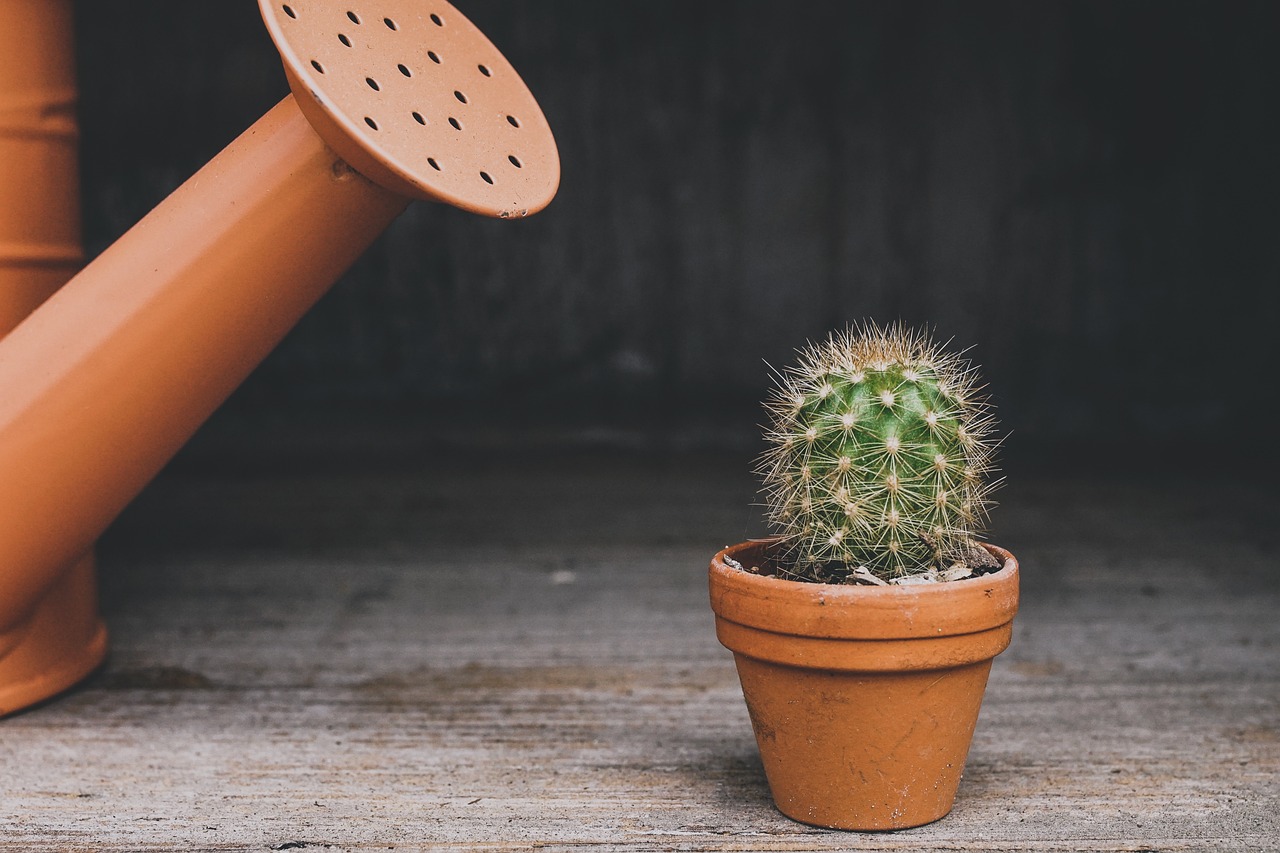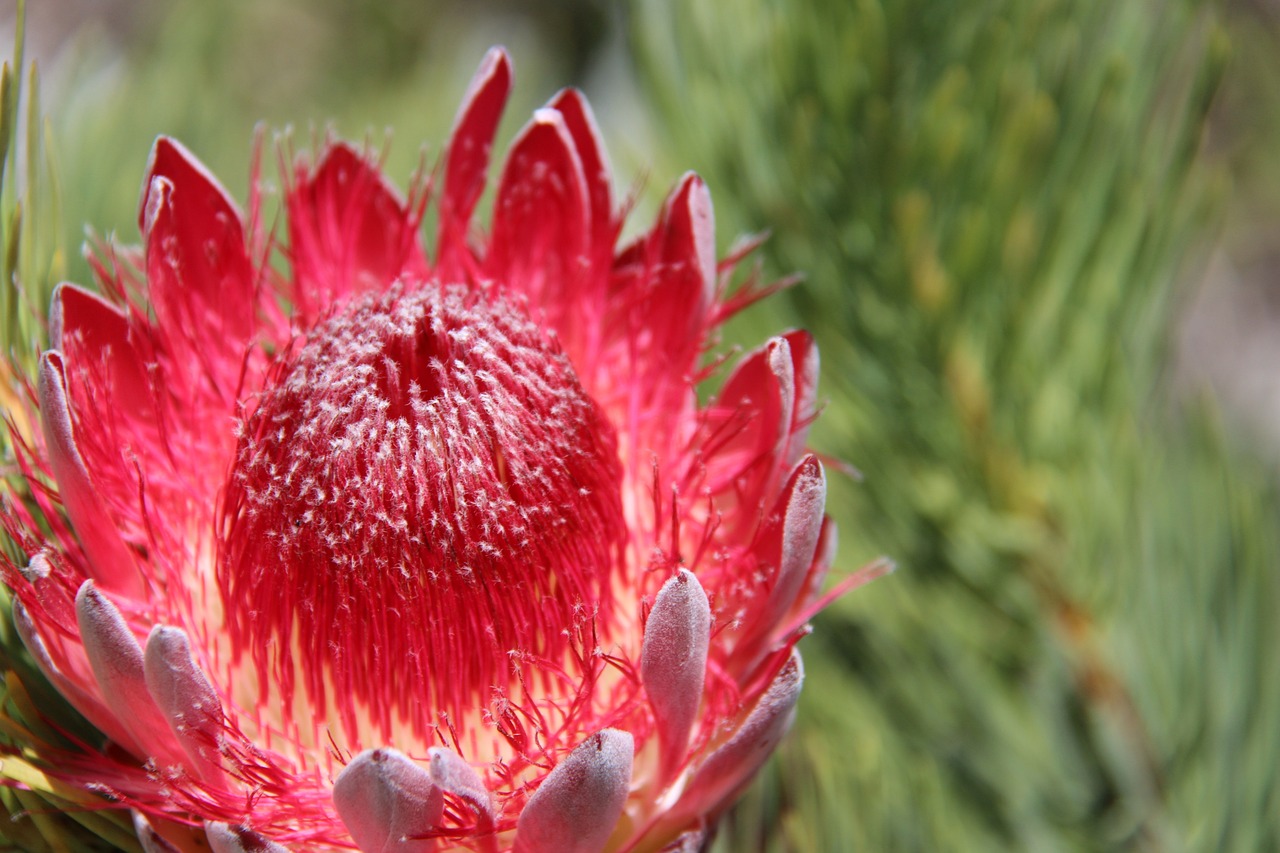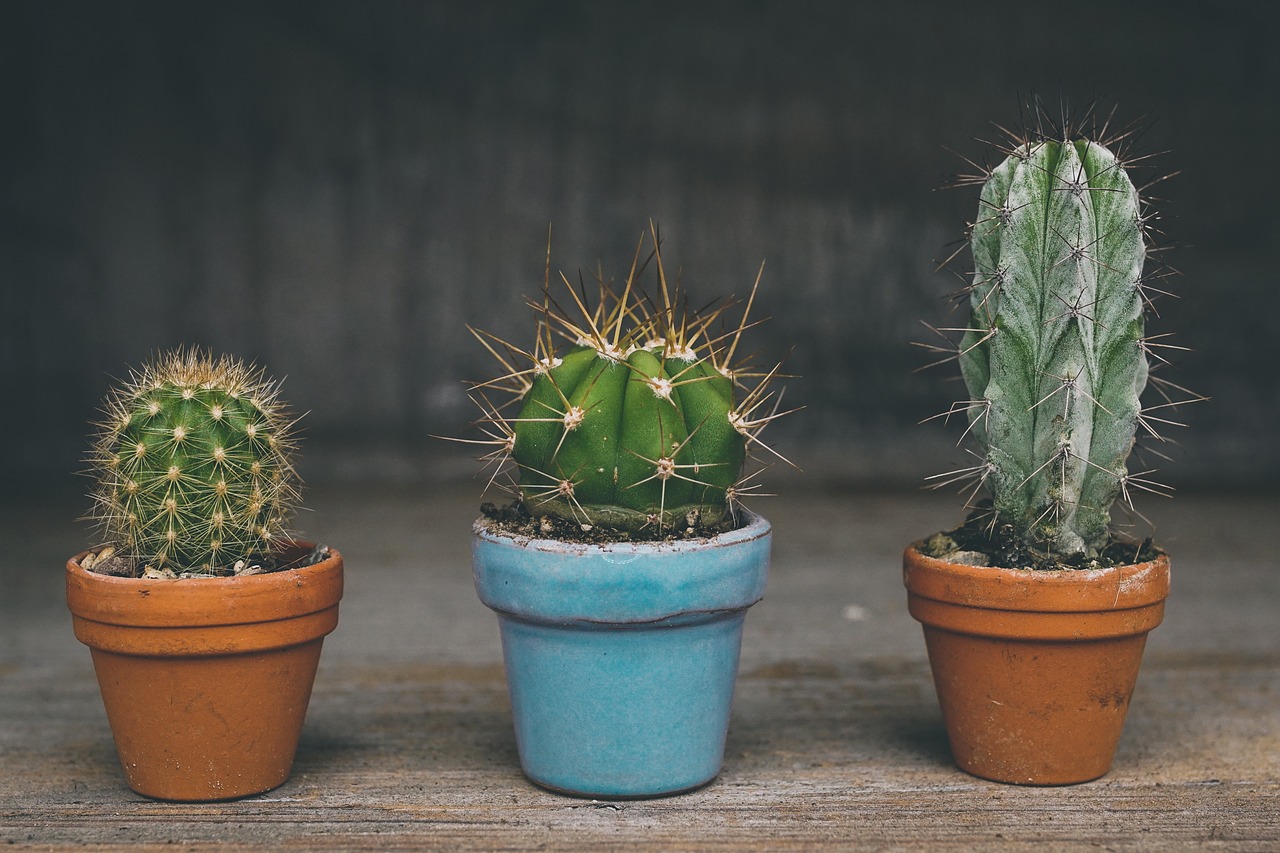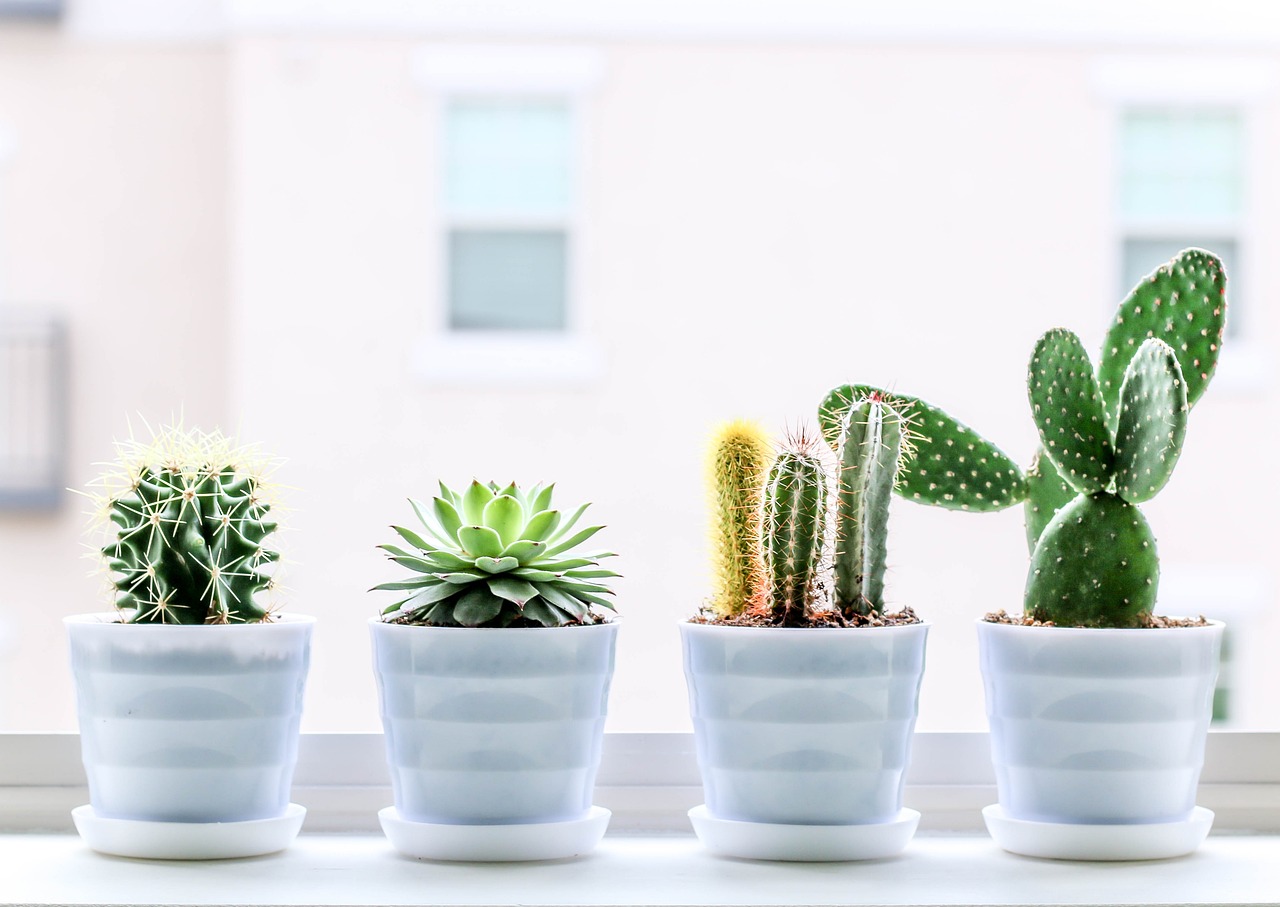Successfully Growing Cacti in Your Home
Growing cacti indoors is not just a trend; it's a lifestyle choice that brings a touch of the desert into your home. With their stunning shapes and vibrant colors, cacti can transform any dull corner into a lively space. But what makes them truly appealing is their low-maintenance nature. If you're wondering how to keep these fascinating plants thriving, you're in the right place! This article will guide you through essential tips and techniques for cultivating cacti indoors, ensuring they flourish in your home environment while showcasing their unique beauty.
Before you dive into the world of indoor gardening, it's essential to choose the right species of cactus for your space. Not all cacti are created equal, and understanding their specific care requirements can make all the difference. Popular varieties like the Golden Barrel, Christmas Cactus, and Hedgehog Cactus each have unique characteristics that suit different indoor conditions. For instance, the Christmas Cactus prefers a bit more humidity compared to its desert-dwelling cousins. When selecting your cactus, consider factors such as light availability, temperature, and humidity levels in your home.
Cacti are sun-worshippers, and understanding their light requirements is crucial for their growth. Ideally, cacti thrive in bright, indirect sunlight. Placing them near a south-facing window is often the best choice. However, if you notice your cactus stretching towards the light, it might be a sign that it needs more exposure. Remember, not all cacti are the same; some may require slightly different lighting conditions. For example, while the Hedgehog Cactus loves bright light, the Christmas Cactus prefers a bit of shade during the hottest part of the day.
When it comes to lighting, you have two main options: natural and artificial light. Natural light is ideal because it mimics the conditions cacti would experience in their native habitats. However, during the winter months or in homes with limited sunlight, artificial lighting can be a lifesaver. Each type has its benefits and drawbacks:
| Type | Benefits | Drawbacks |
|---|---|---|
| Natural Light | Free and effective, promotes natural growth | Limited by seasons and weather |
| Artificial Light | Consistent and controllable, can be used year-round | Can be costly, requires setup |
If you find that natural light is insufficient for your cacti, consider investing in grow lights. These specialized lights are designed to provide the spectrum of light that plants need to thrive. When using grow lights, aim for a duration of about 12-14 hours a day for optimal growth. Position the lights about 12-24 inches above your cactus, and adjust as needed to prevent burning.
As seasons change, so do your cacti's light needs. Gradually acclimating your plants to varying light conditions is essential to avoid shock. For instance, during the summer, you might need to move your cactus further from the window to prevent sunburn. A good rule of thumb is to make adjustments slowly—about an inch a week—allowing your cactus to adapt comfortably.
Watering is perhaps the most critical aspect of cactus care. Too much water can lead to root rot, while too little can cause your cactus to shrivel up. The key is to water deeply but infrequently. Typically, this means watering every two to three weeks, depending on your indoor climate. Always check the soil moisture before watering; if the top inch of soil feels dry, it’s time to hydrate! Signs of overwatering include yellowing stems and mushy roots, while underwatering might show up as shriveled or browning pads.
Choosing the right soil and potting technique can significantly affect cactus growth. A well-draining soil mix is essential; look for one specifically formulated for cacti and succulents. You can also create your own mix by combining regular potting soil with sand and perlite. Regarding pots, opt for clay or terracotta containers with drainage holes to prevent water accumulation, which can be detrimental to your cactus.
Repotting is sometimes necessary for cactus growth, especially if you notice roots poking out of the drainage holes or the plant has outgrown its pot. When repotting, choose a pot that is only slightly larger than the current one to avoid excess soil that can retain moisture. Use gloves to protect your hands from spines, and gently loosen the roots before placing the cactus in its new home. Water it lightly after repotting to help it settle in.
Cacti can be susceptible to pests and diseases, including mealybugs, spider mites, and fungal infections. Regularly inspect your plants for any signs of trouble. If you notice pests, a gentle wash with soapy water can often do the trick. For diseases, ensuring proper air circulation and avoiding overwatering are crucial preventive measures. Remember, a healthy cactus is a happy cactus!
Q: How often should I water my cactus?
A: Water your cactus every two to three weeks, allowing the soil to dry out completely between waterings.
Q: Can I use regular potting soil for my cactus?
A: It’s best to use a soil mix specifically designed for cacti or succulents to ensure proper drainage.
Q: What should I do if my cactus is turning yellow?
A: Yellowing can be a sign of overwatering. Check the soil moisture and reduce watering frequency if necessary.
Q: Do cacti need fertilizer?
A: Yes, during the growing season (spring and summer), you can use a diluted cactus fertilizer every month.

Choosing the Right Cactus
When it comes to selecting the perfect cactus for your home, it’s not just about picking the prettiest one you see. You want to consider a variety of factors that will ensure your new green friend thrives in your indoor environment. Cacti come in many shapes and sizes, each with its own unique care requirements, so understanding these can help you make an informed choice.
Some of the most popular cactus varieties include:
- Golden Barrel Cactus: Known for its round shape and vibrant yellow spines, this cactus is a favorite for beginners. It requires bright light and infrequent watering, making it a low-maintenance option.
- Christmas Cactus: Unlike most cacti, this beauty blooms in winter. It prefers indirect light and higher humidity, so it's perfect for those living in more humid climates.
- Fishhook Barrel Cactus: This species has a distinctive hooked spine and can grow quite tall. It thrives in bright, direct sunlight and should be watered sparingly.
- Hedgehog Cactus: With its colorful blooms and compact size, the hedgehog cactus is ideal for small spaces. It enjoys full sun and needs a well-draining soil mix.
Before making your choice, consider the light and temperature conditions in your home. Some cacti need a lot of direct sunlight, while others can thrive in lower light settings. For instance, if your home has bright, sunny windows, you might opt for sun-loving varieties like the Golden Barrel or Fishhook Barrel. On the other hand, if you have less natural light, the Christmas Cactus could be your best bet.
Another crucial aspect to consider is the size of the cactus. If you have limited space, smaller varieties like the Hedgehog Cactus are perfect. However, if you have room to spare, larger specimens can serve as stunning focal points in your decor. Remember, the size of the pot also plays a role in your cactus's growth; ensure that it has enough space to develop its roots without becoming root-bound.
Lastly, don’t forget to check for pests and diseases before bringing your cactus home. Inspect the plant for any signs of infestation, such as webbing or discolored patches, which can indicate pests like spider mites or mealybugs. A healthy cactus will not only look better but will also be easier to care for in the long run.
In summary, choosing the right cactus involves understanding your home environment, considering the specific needs of various species, and ensuring the plant is healthy before purchase. With the right selection, you’ll not only enjoy the beauty of these resilient plants but also the satisfaction of nurturing them to thrive indoors.

Optimal Light Conditions
When it comes to growing cacti indoors, are absolutely essential for their health and vitality. Cacti are naturally found in arid environments where they bask in bright sunlight for most of the day. Therefore, replicating these conditions in your home is crucial to ensure they thrive. The first step is to identify the ideal locations in your home that can provide ample sunlight. South-facing windows are often the best choice, as they receive the most direct sunlight throughout the day. If you have a sunny balcony, that can also be a fantastic spot for your cacti to soak up those rays.
However, not all cacti are created equal. Different species have varying light requirements. For instance, some cacti, like the Golden Barrel Cactus, love full sun, while others, such as the Christmas Cactus, prefer indirect light. Understanding these needs can make all the difference in keeping your plants healthy and vibrant. To help you navigate these differences, here's a quick reference table:
| Cactus Species | Light Preference |
|---|---|
| Golden Barrel Cactus | Full Sun |
| Christmas Cactus | Indirect Light |
| Hedgehog Cactus | Bright, Direct Light |
| Fishhook Cactus | Full Sun |
Now, let’s dive into the types of light your cacti can receive: natural versus artificial light. Natural light is often the best option, as it provides a full spectrum that supports healthy growth. However, what if your home doesn’t get enough sunlight? This is where artificial lighting comes into play. Using grow lights can be a game-changer for indoor gardening. They can mimic the sun’s rays, allowing your cacti to flourish even in dim conditions. But remember, not all grow lights are created equal. Some are better suited for cacti than others, so do your research to find the right fit!
Another important aspect to consider is how to adjust light exposure as the seasons change. During the summer months, your cacti might bask in sunlight for hours, but come winter, you may need to rotate their position to ensure they still receive adequate light. Gradually acclimating your plants to different light conditions can prevent shock and promote healthy growth. A simple tip is to move them a little closer to the window during the darker months, but be cautious—too much sudden exposure can cause sunburn on your beloved plants!
In summary, providing the right light conditions is vital for your indoor cacti. Whether you’re utilizing natural sunlight or supplementing with grow lights, understanding the specific needs of your cactus species and adjusting to seasonal changes will ensure your plants remain healthy and beautiful. So, are you ready to let your cacti bask in the glow of optimal light conditions?
- How much light do cacti need? Most cacti thrive in bright, direct sunlight for several hours a day.
- Can I use regular light bulbs for my cacti? While regular bulbs can provide some light, it's best to use grow lights specifically designed for plants.
- What should I do if my cactus is getting too much light? If you notice discoloration or burning, move it to a location with less direct sunlight.

Natural vs. Artificial Light
When it comes to nurturing your cacti, understanding the difference between natural and artificial light is key to their thriving health. Cacti, being native to arid regions, are accustomed to basking under the sun's warm embrace. However, not everyone has access to the perfect sunlit window or a greenhouse. So, what are the best options for your indoor cactus garden? Let’s break it down!
Natural light is often the preferred choice because it provides a full spectrum of light that mimics the sun. Placing your cacti near a south or west-facing window typically offers the most intense light. However, there are a few things to keep in mind:
- Seasonal Changes: As the seasons change, the angle and intensity of sunlight can vary significantly. During winter months, you might notice your cactus stretching towards the light, a sign that it might need more exposure.
- Window Treatments: If your windows are covered with heavy drapes or tinted glass, it can filter out much-needed sunlight. Consider using sheer curtains to allow more light in while reducing harsh rays.
On the flip side, artificial light can be a game-changer, especially for those living in less sunny climates or with limited window space. Grow lights can effectively supplement or even replace natural light. Here’s why you might choose artificial lighting:
- Control: You can control the duration and intensity of light exposure, creating a stable environment for your cacti.
- Variety: There are various types of grow lights available, including LED, fluorescent, and incandescent, each with its own benefits.
However, it’s essential to understand the drawbacks of artificial lighting. For instance, it can be less effective in replicating the full spectrum of sunlight that cacti thrive on. Plus, if not monitored correctly, overexposure to artificial light can lead to heat stress or even burning your plants. Balancing the two types of light can yield the best results. For example, using natural light during the day and supplementing with grow lights in the evening can create an ideal environment for your cacti.
In conclusion, whether you opt for natural or artificial light—or a combination of both—what matters most is observing your cacti closely. Are they growing well? Are they showing signs of distress? Adjusting your light setup based on their feedback will lead you to a thriving indoor cactus garden.
Q: How many hours of light do cacti need?
A: Most cacti thrive on about 12 to 14 hours of light per day, whether from natural or artificial sources. Adjust based on the specific species you have.
Q: Can I use regular light bulbs for my cacti?
A: While regular bulbs can provide some light, they may not offer the full spectrum needed for optimal growth. LED or fluorescent grow lights are recommended for best results.
Q: How do I know if my cactus is getting too much light?
A: Signs of too much light include yellowing or browning of the cactus skin and a stretched appearance. If you notice these symptoms, consider relocating your cactus to a spot with less direct sunlight.

Using Grow Lights
When natural sunlight isn’t enough to keep your cacti happy and healthy, grow lights come to the rescue! These artificial lights can mimic the sun's rays, providing the necessary energy for your plants to photosynthesize. But before you rush out to buy the first grow light you see, let’s dive into the different types available and how to use them effectively.
There are several types of grow lights to consider, each with its own set of advantages:
- LED Grow Lights: These are energy-efficient and have a long lifespan. They emit very little heat, making them safe to use close to your cacti.
- Fluorescent Lights: Affordable and easy to find, fluorescent lights are great for smaller setups. They work well for seedlings and young plants.
- High-Intensity Discharge (HID) Lights: These are powerful and effective for larger cacti collections but can generate a lot of heat, requiring careful placement.
Choosing the right type depends on your specific needs, including the size of your cactus collection and your budget. Once you’ve decided on a grow light, it’s crucial to position it correctly. Ideally, grow lights should be placed about 12 to 24 inches above your cacti. This distance helps prevent any potential burning from excessive heat while still providing ample light. Remember, every cactus has its own light needs, so you might need to experiment a bit to find the sweet spot.
Another important factor to consider is the duration of light exposure. Most cacti thrive with around 12 to 14 hours of light per day, mimicking their natural habitat. Using a timer can simplify this process, ensuring your plants receive consistent light without the hassle of manual adjustments.
Lastly, keep an eye on your cacti as they adapt to their new light source. If you notice signs of stretching or leaning, it could indicate that they’re not getting enough light. Conversely, if the cacti appear bleached or scorched, they may be receiving too much. Adjusting the height of your grow light or the duration of exposure can help you strike the perfect balance.
In summary, grow lights can be a game-changer for indoor cactus enthusiasts. With the right type, proper positioning, and careful monitoring, you can create an environment where your cacti can truly thrive, even in the absence of natural sunlight.
Here are some common questions and answers regarding the use of grow lights for cacti:
- How long should I keep grow lights on for my cacti? Aim for about 12 to 14 hours of light per day.
- Can I use regular light bulbs instead of grow lights? While regular bulbs can provide some light, they may not offer the right spectrum for optimal cactus growth.
- Do I need to adjust the height of the grow light? Yes, adjust the height based on your cactus's response to the light to prevent burning or stretching.

Adjusting Light Exposure
Just like us, cacti have their own preferences when it comes to light exposure. As the seasons change, so do the light conditions in your home. This means that your little spiky friends may need some adjustments to keep them thriving. Think of it like adjusting your wardrobe for the weather; you wouldn't wear a winter coat in July, right? Similarly, your cacti need to be gradually acclimated to varying light levels throughout the year.
During the summer months, when the sun is blazing, your cacti might be basking in all that glorious light. However, as the days grow shorter and the sunlight becomes less intense in the winter, it’s crucial to reassess their light situation. If your cactus is used to bright, direct sunlight, suddenly placing it in a dimmer spot could lead to stress, which manifests as etiolation—a fancy term for when a cactus stretches towards the light, losing its compact shape.
To help your cacti adjust, you can follow these simple steps:
- Gradual Transition: Move your cactus to a new location gradually, shifting it a few inches at a time over several days. This will help it adapt without causing shock.
- Rotate Your Plants: Rotating your cacti can ensure that all sides receive equal light exposure, promoting even growth.
- Monitor Their Response: Keep a close eye on your cacti after making any changes. Look for signs of stress, such as discoloration or drooping, and adjust accordingly.
If you find that your indoor lighting is inadequate, especially during the darker months, consider using grow lights. These can mimic the perfect light spectrum that cacti crave, ensuring they stay healthy and vibrant. Just remember to keep the lights a safe distance away to prevent overheating or scorching your plants.
In conclusion, adjusting light exposure for your cacti is essential for their well-being. By being attentive and responsive to their needs, you can create an environment where they flourish, showing off their unique beauty all year round. After all, a happy cactus means a happy home!

Watering Techniques
When it comes to watering your cacti, understanding the unique needs of these resilient plants is crucial. Unlike many other houseplants that thrive on consistent moisture, cacti have adapted to survive in arid environments. This means that overwatering is one of the most common mistakes new cactus owners make. So, how do you ensure your prickly friends get the right amount of water? Let’s dive into some effective watering techniques!
First and foremost, it’s essential to recognize that cacti prefer to dry out completely between waterings. This means that you should only water your cactus when the soil is completely dry to the touch. A good rule of thumb is to stick your finger about an inch into the soil; if it feels dry, it’s time to water. If it still feels damp, wait a few more days. This simple technique can help prevent the dreaded root rot that can occur when cacti sit in soggy soil.
Now, let’s talk about how to water effectively. When you do water, it’s best to do so thoroughly. This means giving your cactus a good soak until water drains out of the bottom of the pot. This ensures that the roots are adequately hydrated while allowing excess water to escape, preventing any water from pooling at the bottom. You might want to consider using a watering can with a long spout for better control and precision. Remember, it’s better to underwater than overwater!
Seasonality also plays a significant role in how often you should water your cactus. During the growing season, typically from spring to summer, your cactus will benefit from more frequent watering—about every two to three weeks. However, as the days grow shorter and temperatures drop in the fall and winter, your cactus will enter a dormant phase. During this time, you should reduce watering to once a month or even less, depending on the humidity levels in your home.
Here’s a quick reference table to help you remember the watering schedule:
| Season | Watering Frequency |
|---|---|
| Spring to Summer | Every 2-3 weeks |
| Fall to Winter | Once a month or less |
Lastly, keep an eye out for signs that your cactus may need more or less water. If you notice your cactus becoming wrinkled or shriveled, it might be thirsty. Conversely, if the cactus is turning yellow or mushy, it’s likely receiving too much water. By tuning into your plant's signals, you can adjust your watering routine accordingly and keep your cactus healthy and thriving.
In summary, mastering the art of watering your cactus is all about understanding its natural habitat and adjusting your care routine accordingly. With the right techniques, you'll not only keep your cacti alive but also allow them to flourish, showcasing their unique beauty in your home.
- How often should I water my cactus? Water your cactus every 2-3 weeks during the growing season and reduce to once a month in winter.
- What signs indicate that my cactus is overwatered? Yellowing or mushy stems are common signs of overwatering.
- Can I use regular potting soil for my cactus? It's best to use a well-draining cactus mix or create your own by mixing potting soil with sand or perlite.
- Should I water my cactus with tap water? If possible, use distilled or rainwater to avoid chemicals found in tap water that can harm your cactus.

Soil and Potting Considerations
When it comes to successfully nurturing your cacti, the right soil and potting techniques play a pivotal role. Cacti are unique in their needs, thriving in environments that mimic their natural arid habitats. This means that your choice of soil must facilitate excellent drainage while providing the necessary nutrients. A typical potting mix for cacti should consist of a blend of sand, perlite, and potting soil in a ratio that ensures both aeration and moisture retention without becoming soggy.
For instance, a popular recipe for cactus soil is a mix of 50% potting soil, 25% perlite, and 25% coarse sand. This combination allows for quick drainage, which is essential to prevent root rot, a common issue among indoor cacti. Additionally, using a pot with drainage holes is non-negotiable; without them, your cactus could drown in its own water.
When selecting pots, consider materials as well. Terracotta pots are a fantastic option because they are porous, allowing moisture to escape and air to circulate around the roots. On the other hand, plastic pots retain moisture longer, which might not be ideal for cacti. If you choose plastic, ensure that you monitor the watering closely to avoid over-saturation.
As your cactus grows, you may need to repot it to provide more space for its roots. This is typically necessary every two to three years, depending on the species and growth rate. When repotting, gently remove the cactus from its old pot, taking care not to damage the roots. If the roots appear crowded or wrapped around each other, it’s a good time to trim them back slightly. Then, place the cactus in a new pot that is only slightly larger than the previous one, as too much space can lead to overwatering issues.
So, how do you know when it’s time to repot? Look for signs such as roots growing out of the drainage holes or stunted growth despite proper care. If your cactus seems to be struggling, it might be a sign that it needs more room to breathe.
In summary, the right soil and potting considerations are fundamental to the health of your cacti. By ensuring proper drainage, selecting the right materials, and knowing when to repot, you’re setting your indoor garden up for success. Remember, cacti are resilient, but they thrive best when their environmental needs are met.
- What type of soil is best for cacti? A mix of potting soil, perlite, and coarse sand is ideal for ensuring good drainage.
- How often should I repot my cactus? Generally, every two to three years, or when you notice signs of root crowding.
- Can I use regular potting soil for cacti? While you can, it’s better to mix it with sand and perlite to improve drainage.
- What kind of pot should I use? Terracotta pots are recommended for their breathability, but plastic pots can work if monitored closely.

Repotting Your Cactus
Repotting your cactus may seem like a daunting task, but it's essential for maintaining its health and promoting growth. Just like us, cacti can outgrow their homes! When you notice that your cactus is becoming root-bound, or if the soil appears depleted or compacted, it’s time to consider repotting. This process not only provides your plant with fresh nutrients but also allows for better drainage and root expansion, which is crucial for its overall wellbeing.
Before diving into the repotting process, it’s important to gather the right materials. You’ll need a new pot that is slightly larger than the current one, cactus soil mix, and some gardening gloves to protect your hands from those prickly spines. Cactus soil is specially formulated to provide excellent drainage, which is vital because cacti are particularly sensitive to overwatering.
Here’s a simple step-by-step guide to help you repot your cactus safely:
- Choose the Right Time: The best time to repot your cactus is during the spring or early summer when it is actively growing. This helps the plant recover more quickly from the shock of being moved.
- Prepare the New Pot: Make sure your new pot has drainage holes at the bottom. Fill the bottom with a layer of gravel or small stones to enhance drainage.
- Remove the Cactus: Gently grasp the cactus by its base, using gloves or a towel to protect your hands. Carefully wiggle it out of its old pot. If it's stubborn, you may need to tap the sides of the pot to loosen it.
- Inspect the Roots: Once out, examine the roots. Trim any that appear brown or mushy, as these indicate rot. Healthy roots should be white and firm.
- Plant in the New Pot: Place your cactus in the center of the new pot and fill around it with fresh cactus soil, ensuring that the top of the root ball is level with the rim of the pot. Firm the soil gently but avoid packing it too tightly.
- Water Sparingly: After repotting, wait a week before watering to allow the roots to settle in. When you do water, ensure that the soil dries out completely between waterings.
Repotting can be a bit stressful for your cactus, but with the right care, it will bounce back and thrive in its new environment. Remember, patience is key! Over time, you’ll see your cactus flourish, and it will become an even more stunning addition to your indoor garden.
Q: How often should I repot my cactus?
A: Generally, cacti should be repotted every 2-3 years, or whenever you notice signs of being root-bound or if the soil appears to be depleted.
Q: Can I use regular potting soil for my cactus?
A: It’s best to use a specialized cactus soil mix, as it provides the necessary drainage that cacti require to thrive.
Q: What should I do if my cactus is too big to handle?
A: If your cactus is too large to handle safely, consider using a towel to grip it or ask someone for assistance. Always prioritize safety to avoid injury.
Q: What are the signs that my cactus needs repotting?
A: Signs include roots growing out of the drainage holes, stunted growth, or soil that dries out too quickly. If you notice any of these, it’s time to repot!

Common Pests and Diseases
Cacti, despite their hardy reputation, can fall victim to a variety of pests and diseases that can compromise their health and beauty. Understanding these threats is key to maintaining a thriving indoor cactus garden. One of the most common culprits is the mealybug, a small, white, cottony pest that loves to hide in the crevices of your cactus. They suck the sap from the plant, leading to stunted growth and yellowing. If you notice these little invaders, don't panic! A cotton swab dipped in rubbing alcohol can help wipe them away effectively.
Another frequent visitor is the spider mite. These tiny arachnids thrive in dry conditions and can cause significant damage by feeding on the plant's juices. You'll recognize them by the fine webbing they leave behind. To combat spider mites, increase humidity around your cacti and consider using insecticidal soap if the infestation is severe.
Fungal infections can also pose a threat, especially if your cactus is overwatered. Root rot is a common issue that can occur when the roots sit in soggy soil. The telltale signs include a mushy base and a foul smell. To prevent root rot, ensure your cactus is planted in well-draining soil and only water when the soil is completely dry. If you suspect root rot has set in, you may need to repot your cactus, trimming away any affected roots.
To help you keep track of the most common pests and diseases, here’s a quick reference table:
| Pest/Disease | Symptoms | Treatment |
|---|---|---|
| Mealybug | White cottony masses on the plant | Remove with rubbing alcohol |
| Spider Mite | Fine webbing, yellow spots | Increase humidity, use insecticidal soap |
| Root Rot | Mushy base, foul smell | Repot, trim affected roots, improve drainage |
Additionally, it's important to regularly inspect your cacti for any signs of distress. A quick check can save your plants from the worst effects of these pests and diseases. Remember, prevention is always better than cure! Keeping your cacti in optimal conditions—adequate light, proper watering, and good air circulation—will keep these unwanted visitors at bay.
In conclusion, while cacti are generally low-maintenance plants, they are not entirely immune to pests and diseases. By staying vigilant and addressing any issues promptly, you can ensure your indoor garden remains a vibrant and healthy oasis. If you ever find yourself in doubt, don’t hesitate to reach out to local gardening communities or experts for advice!
- What is the best way to prevent pests on my cactus? Regularly inspect your plants and maintain optimal growing conditions to deter pests.
- How can I tell if my cactus is overwatered? Look for signs like mushy stems or yellowing leaves; these are indicators of root rot.
- Can I use household items to treat pests? Yes, rubbing alcohol and insecticidal soap can be effective against many common pests.
- What should I do if I find root rot? Repot your cactus immediately, trimming away any rotten roots and ensuring better drainage.
Frequently Asked Questions
- What type of cactus is best for beginners?
If you're just starting your cactus journey, the Golden Barrel cactus or the Easter Lily cactus are fantastic choices. They are not only resilient but also require minimal care, making them perfect for novice plant parents.
- How much light do cacti need?
Cacti thrive in bright, direct sunlight for at least 6 hours a day. If your home doesn't get enough natural light, consider placing them near south-facing windows or using grow lights to supplement their needs.
- Can I use regular potting soil for my cactus?
It's best to avoid regular potting soil as it retains too much moisture. Instead, opt for a cactus-specific soil mix or create your own by combining potting soil with sand and perlite to ensure proper drainage.
- How often should I water my cactus?
Watering frequency can vary based on the season and environment. Generally, during the growing season (spring and summer), water your cactus every 2-3 weeks. In the dormant season (fall and winter), reduce watering to once a month or less.
- What are the signs of overwatering my cactus?
Watch for signs like yellowing or mushy stems, and a general wilting appearance. If you notice these symptoms, it might be time to let the soil dry out completely before watering again.
- How do I know when to repot my cactus?
It's time to repot when you see roots growing out of the drainage holes or if the plant seems top-heavy. Typically, cacti should be repotted every 2-3 years to refresh the soil and provide more space for growth.
- What pests should I look out for on my cactus?
Common pests include mealybugs, spider mites, and scale insects. Regularly inspect your plants and treat any infestations promptly with insecticidal soap or neem oil to keep your cactus healthy.
- Can I use artificial lights for my cactus?
Absolutely! If natural light is lacking, using grow lights can be an excellent alternative. Just ensure they provide the right spectrum and intensity to mimic natural sunlight for optimal growth.



















